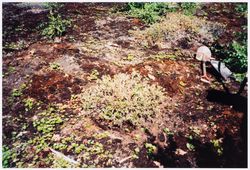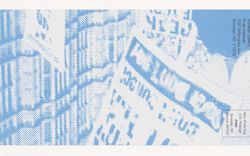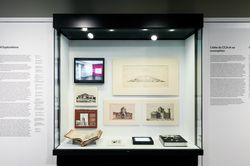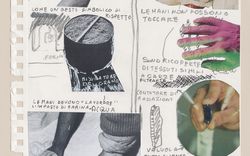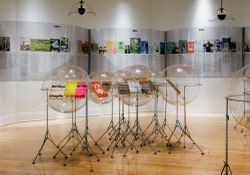outils d'aujourd'hui 2018, activismes, Tatjana Schneider, Pelin Tan, Andreas Rumpfhuber, Torsten Lange, Charles Davis II
9 juillet 2018 au 13 juillet 2018
outils d'aujourd'hui 2018, activismes, Tatjana Schneider, Pelin Tan, Andreas Rumpfhuber, Torsten Lange, Charles Davis II
Où – et comment – nous voulons habiter en vieillissant? Nos quartiers, nos immeubles, nos villes sauront-ils s’adapter à nos besoins? La soirée Où vieillir? débute par la projection du documentaire Where We Grow Older (CCA, 2023, 30 min), qui explore comment l’architecture et l’urbanisme peuvent répondre aux défis du vieillissement démographique. La projection sera(...)
Théâtre Paul-Desmarais
5 février 2026, 18h
Film et discussion : Où vieillir ?
Actions:
Description:
Où – et comment – nous voulons habiter en vieillissant? Nos quartiers, nos immeubles, nos villes sauront-ils s’adapter à nos besoins? La soirée Où vieillir? débute par la projection du documentaire Where We Grow Older (CCA, 2023, 30 min), qui explore comment l’architecture et l’urbanisme peuvent répondre aux défis du vieillissement démographique. La projection sera(...)
Théâtre Paul-Desmarais
articles
14 avril 2025
Les architectes lancent un appel...
Lisa Belabed et Auden Young Tura sur l’activisme dans l’architecture
Actions:
À l’occasion des 90 ans de Phyllis Lambert, cette exposition offre un aperçu autobiographique de l’évolution des idées de la fondatrice du CCA et de son travail architectural, éditorial, curatorial et d’activisme. L’exposition met en lumière l’engagement résolu de Phyllis Lambert envers la ville et la recherche intellectuelle, en présentant des documents de la collection(...)
Vitrines
18 janvier 2017 au 11 juin 2017
Phyllis Lambert : 75 ans au travail
Actions:
Description:
À l’occasion des 90 ans de Phyllis Lambert, cette exposition offre un aperçu autobiographique de l’évolution des idées de la fondatrice du CCA et de son travail architectural, éditorial, curatorial et d’activisme. L’exposition met en lumière l’engagement résolu de Phyllis Lambert envers la ville et la recherche intellectuelle, en présentant des documents de la collection(...)
Vitrines
articles
Traces de contestations
31 mars 2025
Traces de contestations
Irene Chin, Auden Young Tura, Lisa Belabed, Laura Aparicio Llorente et Megan Marin montrent comment les architectes s’engagent dans les crises de leur temps
Actions:
Monter/Brocher/Plier 2 : l’architecture radicale dans la presse parallèle des années 196X-197X
Inventée au début du XXe siècle pour désigner les périodiques littéraires progressistes, l’expression « little magazine » a été réutilisée au cours des années 1960 pour qualifier la vague de périodiques d’architecture indépendants qui a alors déferlé en réaction aux changements politiques, sociaux et artistiques à cette époque. Monter/Brocher/Plier 2 examine comment un(...)
Salle octogonale et rotonde de la bibliothèque
12 avril 2007 au 9 septembre 2007
Monter/Brocher/Plier 2 : l’architecture radicale dans la presse parallèle des années 196X-197X
Actions:
Description:
Inventée au début du XXe siècle pour désigner les périodiques littéraires progressistes, l’expression « little magazine » a été réutilisée au cours des années 1960 pour qualifier la vague de périodiques d’architecture indépendants qui a alors déferlé en réaction aux changements politiques, sociaux et artistiques à cette époque. Monter/Brocher/Plier 2 examine comment un(...)
Salle octogonale et rotonde de la bibliothèque
Série(s)
Hans Hansen
AP162.S4
Description:
Series documents the contribution of architect Hans Hansen to the correspondence circle of Die gläserne Kette, with Hansen writing under the pseudonym Antischmitz. Born in Roetgen, Germany, in 1886, Hansen studied architecture in Cologne. After the war, Hansen joined the circle Cologne Dadaists, contributed to the magazine "Der Ventilor", and published "Das Erlebnis der Architektur". From 1922, he worked on commissions for the Catholic Church in Germany, including his most known project for the St. Bruno Church in Cologne-Kletteberg (1924-1926). He died in Cologne in 1966. (Source: Ian Boyd Whyte, Bruno Taut and the Architecture of Activism. Cambridge: Cambridge University Press, 1982) The series comprises part of the correspondence of Hans Hansen to the Die gläserne Kette circle.
1920
Hans Hansen
Actions:
AP162.S4
Description:
Series documents the contribution of architect Hans Hansen to the correspondence circle of Die gläserne Kette, with Hansen writing under the pseudonym Antischmitz. Born in Roetgen, Germany, in 1886, Hansen studied architecture in Cologne. After the war, Hansen joined the circle Cologne Dadaists, contributed to the magazine "Der Ventilor", and published "Das Erlebnis der Architektur". From 1922, he worked on commissions for the Catholic Church in Germany, including his most known project for the St. Bruno Church in Cologne-Kletteberg (1924-1926). He died in Cologne in 1966. (Source: Ian Boyd Whyte, Bruno Taut and the Architecture of Activism. Cambridge: Cambridge University Press, 1982) The series comprises part of the correspondence of Hans Hansen to the Die gläserne Kette circle.
series
1920
Série(s)
Hermann Finsterlin
AP162.S1
Description:
Series documents the contribution of artist Hermann Finsterlin to the correspondence circle of Die gläserne Kette. Finsterlin wrote under the pseudonym Prometh (sometime appears as "Prometheus"). Born in Munich in 1897, Finsterlin studied at Munich University in chemistry, then in physics and medicine, and later in philosophy. He studied painting at the Kunstakademie in Munich in 1917 and 1918 and exhibited his work at the Ausstlelling für unbekannte Architekten. He published in "Frühlich", a magazine edited by Bruno Taut in which works by some members of Die gläserne Kette were featured. He painted frescoes in Tripoli, Majorca, and Tenerife. During the Nazi period, Finsterlin was commissionned to paint frescoes and portraits for the regime, but most of his work was destroyed during the war. He died in Stuttgart, Germany, in 1973. (Source: Ian Boyd Whyte, Bruno Taut and the Architecture of Activism. Cambridge: Cambridge University Press, 1982) The series comprises part of the correspondence of Hermann Finsterlin to the Die gläserne Kette circle, including a postcard. The series also includes some drawings by Finsterlin.
1919-1923
Hermann Finsterlin
Actions:
AP162.S1
Description:
Series documents the contribution of artist Hermann Finsterlin to the correspondence circle of Die gläserne Kette. Finsterlin wrote under the pseudonym Prometh (sometime appears as "Prometheus"). Born in Munich in 1897, Finsterlin studied at Munich University in chemistry, then in physics and medicine, and later in philosophy. He studied painting at the Kunstakademie in Munich in 1917 and 1918 and exhibited his work at the Ausstlelling für unbekannte Architekten. He published in "Frühlich", a magazine edited by Bruno Taut in which works by some members of Die gläserne Kette were featured. He painted frescoes in Tripoli, Majorca, and Tenerife. During the Nazi period, Finsterlin was commissionned to paint frescoes and portraits for the regime, but most of his work was destroyed during the war. He died in Stuttgart, Germany, in 1973. (Source: Ian Boyd Whyte, Bruno Taut and the Architecture of Activism. Cambridge: Cambridge University Press, 1982) The series comprises part of the correspondence of Hermann Finsterlin to the Die gläserne Kette circle, including a postcard. The series also includes some drawings by Finsterlin.
series
1919-1923
Série(s)
AP162.S7
Description:
Series documents the contribution of architect Hans Scharoun to the correspondence circle of Die gläserne Kette, with Scharoun writing under the pseudonym Hannes. Born in 1893 in Bremen, Germany, Scharoun studied archictecture at the Technische Hochschule at Berlin-Charlottenburg between 1912 and 1914. From 1915 to 1918 he worked on a military commission for the rebuilding of East Prussia. In 1919, he joined the Arbeitsrat für Kunst led by Bruno Taut. From 1919 to 1925 he worked independently, taking on private and public commissions as well as architectural projects for exhibitions. He taught at the Akademie für Kunst und Gewerbe in Breslau from 1925 to 1932, and at the Technische Universität Berlin as a town planning professor from 1946 to 1958. In 1956, he won the first prize of the competition for the Philharmonie concert hall in West Berlin. He died in Berlin in 1972. (Source: Ian Boyd Whyte, Bruno Taut and the Architecture of Activism. Cambridge: Cambridge University Press, 1982) The series comprises part of the correspondence of Hans Scharoun to the Die gläserne Kette circle and related drawings.
between 1919 and 1920
Hans Scharoun
Actions:
AP162.S7
Description:
Series documents the contribution of architect Hans Scharoun to the correspondence circle of Die gläserne Kette, with Scharoun writing under the pseudonym Hannes. Born in 1893 in Bremen, Germany, Scharoun studied archictecture at the Technische Hochschule at Berlin-Charlottenburg between 1912 and 1914. From 1915 to 1918 he worked on a military commission for the rebuilding of East Prussia. In 1919, he joined the Arbeitsrat für Kunst led by Bruno Taut. From 1919 to 1925 he worked independently, taking on private and public commissions as well as architectural projects for exhibitions. He taught at the Akademie für Kunst und Gewerbe in Breslau from 1925 to 1932, and at the Technische Universität Berlin as a town planning professor from 1946 to 1958. In 1956, he won the first prize of the competition for the Philharmonie concert hall in West Berlin. He died in Berlin in 1972. (Source: Ian Boyd Whyte, Bruno Taut and the Architecture of Activism. Cambridge: Cambridge University Press, 1982) The series comprises part of the correspondence of Hans Scharoun to the Die gläserne Kette circle and related drawings.
series
between 1919 and 1920
Série(s)
AP162.S2
Description:
Series documents the contribution of architect Paul Goesch to the correspondence circle of Die gläserne Kette. Goesch participated using the pseudonym Tancred. Born in Schwerin, Germany in 1985, Goesch studied architecture at the Technische Hochschule at Berlin-Charlottenburg. After his studies, he worked as a civil servant in Kulm and started producing his first drawings and watercolours between 1914 and 1916. He joined the Novembergruppe, an exhibiting group of painters, sculptors, architects and musicians that later merged with the Arbeitsrat für Kunst group led by Bruno Taut. He collaborated with Bruno Taut on the coloured-architecture program in Magdeburg, Germany in 1921, but was later hospitalized for mental illness, first in Göttingen, then in the Teupitz Hospital near Berlin in 1933 or 1934. In 1940, he was taken by the SS to Hartheim Euthanasia Centre where he was murdered on 6 September the same year. (Source: Ian Boyd Whyte, Bruno Taut and the Architecture of Activism. Cambridge: Cambridge University Press, 1982) The series comprises a letter of Paul Goesch to the Die gläserne Kette circle, as well as portraits, including a carte-de-visite, and a diploma.
1890-1911
Paul Goesch
Actions:
AP162.S2
Description:
Series documents the contribution of architect Paul Goesch to the correspondence circle of Die gläserne Kette. Goesch participated using the pseudonym Tancred. Born in Schwerin, Germany in 1985, Goesch studied architecture at the Technische Hochschule at Berlin-Charlottenburg. After his studies, he worked as a civil servant in Kulm and started producing his first drawings and watercolours between 1914 and 1916. He joined the Novembergruppe, an exhibiting group of painters, sculptors, architects and musicians that later merged with the Arbeitsrat für Kunst group led by Bruno Taut. He collaborated with Bruno Taut on the coloured-architecture program in Magdeburg, Germany in 1921, but was later hospitalized for mental illness, first in Göttingen, then in the Teupitz Hospital near Berlin in 1933 or 1934. In 1940, he was taken by the SS to Hartheim Euthanasia Centre where he was murdered on 6 September the same year. (Source: Ian Boyd Whyte, Bruno Taut and the Architecture of Activism. Cambridge: Cambridge University Press, 1982) The series comprises a letter of Paul Goesch to the Die gläserne Kette circle, as well as portraits, including a carte-de-visite, and a diploma.
series
1890-1911
